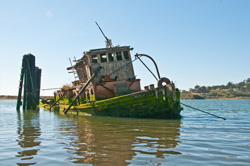Improved biofouling strategies for aquaculture
Antifouling involves preventing or removing the accumulation of microorganisms, plants and animals such as shellfish, algae and plants which collect on ship hulls or fishery installations. The EU-funded project 'Collective research on aquaculture biofouling' (CRAB) aimed to reduce the toxic effects of antifouling strategies through feasible, sustainable systems. The project defined the scientific and economic challenges in antifouling related to aquaculture (for example, in fish farms and in rearing sea organisms), proposing more promising techniques to overcome them. It assessed the requirements and surveyed end users to outline the effects of biofouling on infrastructure and farmed species. CRAB worked on developing existing technology and investigated biological control of critical species, enzyme-based treatments, protective materials, coatings, husbandry, cleaning practices, colour treatment and electrochemical antifouling, among others. It evaluated materials applied to critical aquaculture surfaces, ran farm trials to assess biofouling pressure and tested proposed solutions. The project also conducted an environmental and economic risk assessment of current and alternative technologies, considering safety, health effects, fish stocks and overall economic impacts. The CRAB project outlined best practices in the sector and published the results in a biofouling manual through the project website. Guidelines focused on operating conditions and lowering costs. They also involved criteria such as coating integrity, antifouling efficiency and sustainability to assess different solutions. In addition to online dissemination, the results of the project were communicated through articles, conferences and other events. Lastly, the dissemination was combined with training activities to ensure maximum benefit to the industry and a considerably healthier aquaculture sector.

